Maltese Balcony Mystery: What is the Origin of this Architecture
This article may contain affiliate links where I make a small commission for purchases you make from links that you click from this article. By purchasing through these links, you support me at no additional cost to you. Thanks for your support.
The first thing I noticed in Valletta were the Maltese balconies; colorful, enclosed, wooden, and on every single home. How could you not notice them, they are a staple in the architecture all over the island. So of course I thought I’d write a simple little post on the balconies of Malta accompanied by some photography of the beautiful balconies.
Simple? Not really.
The ‘origin’ question was not a simple question to my surprise. In fact, it lead me on a crazy search around Malta to try to get answers. I went to locals, Google, docents and more to try to find the origin of the Maltese balcony.
Table of Contents
What the Locals Know About the Wooden Balconies
I started asking locals what the origins of the enclosed balconies were. Some people said they had no idea, some people said it was for gossiping (a term that I believe got a little lost in translation), and some people said it was Arabic. I had no definitive answer. But I still kept on taking photos of them.


Maltese Balcony Restoration Project
However, through my conversations with locals I did find out that the government has started an urban regeneration program. They support people financially who restore the wooden balconies. This must be why they stand out so much and normally look so beautifully kept up.
Googling the History of the Maltese Balcony With Little Luck
I continued my balcony education quest with online research. Surely a simple Google search for “Malta enclosed wooden balcony history” would bring me an answer.
Nope.
However I did learn more than I ever thought I’d learn about the history of balconies while searching!
Where did the Balcony Come From?
First, lets start with the definition; derived from the Italian ‘balcone’ meaning scaffold, the High German ‘balcho’ or beam and the Persian term ‘balkaneh’. A balcony is a kind of platform projecting from the wall of a building, supported by columns, brackets or cantilevered and enclosed with a balustrade.
From The Culture of Malta on Wikipedia – it appears that Spain influenced the Maltese balcony:
Traces of the ascendancy of the Crown of Aragon in the Mediterranean, and Spanish governance over Malta from 1282 to 1530, are still evident in Maltese culture today. These include culinary, religious, and musical influences. Two examples are the enduring importance of the Spanish guitar in Maltese folk music, and the enclosed wooden balconies that grace traditional Maltese homes today.
From The History of Balconies – has interesting info on Maltese balconies:
Head for the Mediterranean holiday islands of Malta and Gozo where the balcony is unequivocally an important feature of their streetscape. In 1679, the corner balcony of the Grand Master’s Palace in Valletta is believed to have been the first to become enclosed with a wood and glass structure. This fashion spread to the villages during the 18th century.
In 2007, the ubiquitous Maltese and Gozitan balconies were elevated in status when they featured on a set of five stamps, issued by the Philatelic Bureau of Maltapost, illustrating the development of the islands’ iconic building feature.
From Culture in Malta website – The Aragonese introduced the balconies:
The Arabs introduced citrus trees and the flat-topped houses, and they laid the foundations for the Maltese language. The Aragonese, from central Spain, left their mark in the medieval architecture of Malta’s historic town centers and the enclosed wooden balconies which typify the splendid town houses.
(I even looked up Aragonese to find out if they had some sort of Arabic background – but found no answers. )
From some random website called OoCities – No wait…the balconies come from Arabic origins:
Small-scale wooden balconies started to appear in Valletta during the mid-eighteenth century and gradually gained popularity and became the fashion. This might have been influenced in no small way by the construction of the two grand wooden balconies of the Grand Master’s Palace referred to earlier. So universal was their spread that they eventually came to be referred to by the misleading name of La Maltijja (the Maltese) as if they were original to the place.
In reality this type of balcony was derived from North African, mostly Moroccan, prototypes which again derive from the Arabic Muxrabija (look-out place). During the rule of the Order, Malta was home to a huge number of predominantly Turkish slaves, some of whom were master craftsman who might have helped to introduce the wooden balcony to Malta.
Google gave me no definitive answers.
Let’s keep trying.
Get the Inside View of a Maltese Balcony at Casa Rocca Piccola
I toured a historical house, Casa Rocca Piccola, in Valletta just so that I could go and see the balconies from the inside and hopefully learn more.
The docent was knowledgeable about everything in the house, but when I asked her about the origin of the balconies, she didn’t have an answer.
Enclosed Balconies Were for the Women in Malta
She seemed to think they had an Arabic origin with the idea that the women watched the world go by via their balcony; they could stay ‘out of sight’, but watch what was going on. She pointed out that there was a ‘hidden window’ opening where they could sit on a stool and by simply gazing down, see through the hidden window to the street below. She also added that it was a nice place to sit and enjoy the breeze since the windows on the side open up.
Ok – nice point about the breeze, but why have windows at all? However I couldn’t get sidetracked about windows, I needed to focus on origins!



A ‘Definitive’ Answer to Malta’s Balcony Origin
Finally I went to a revered, ‘this-local-knows-everything’ friend, Francis. He works for NSTS who is co-hosting me along with GeoVisions on this trip – and I asked him the question about the balcony’s origin. Without hesitating he provided me an answer.
He said that it was from Arabic times when women had to be hidden. However the Maltese society didn’t have to hide women, but instead it morphed into the fact that pretty much all women were housewives and they really stayed in the home and didn’t venture out. The saying “a woman’s place is in the home”rings true here. (cringe!)
He went on to explain that the housewives would sit on high stools and watch what was going on outside; in a weird way, it was their reality TV.





My research into Maltese balconies had been exhausted. The Arabic answer seemed to be the most logical, but who really knows? Spanish, Arabic, Turkish, Aragonese…I still have no real idea. But I do know one thing – the balconies are beautiful.
Weigh in on the research – do you know where they came from? If so, please share in the comments!

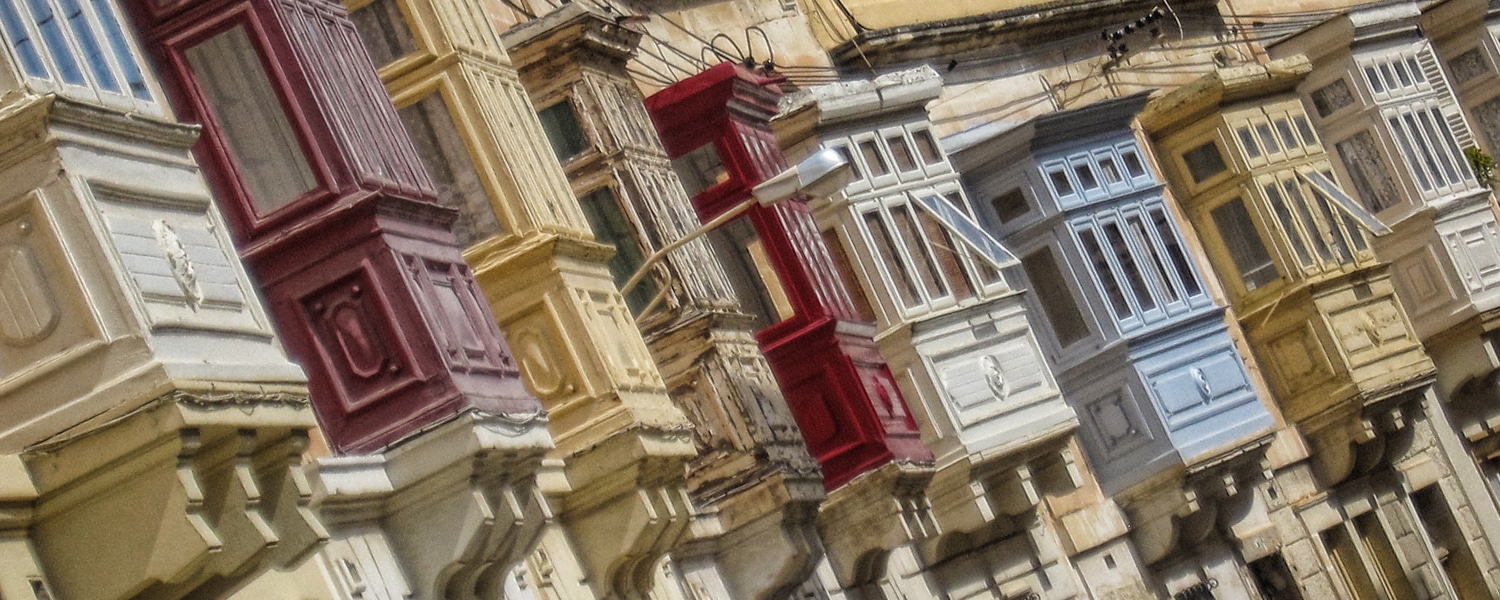
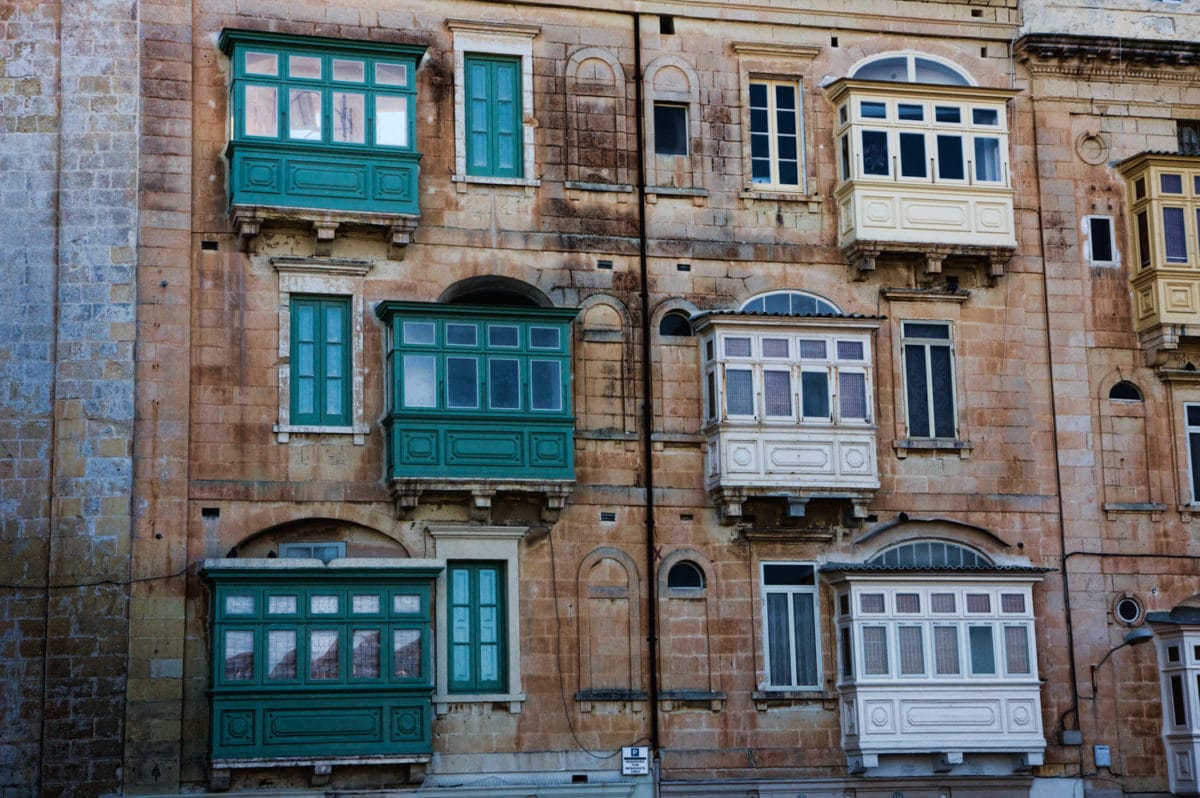

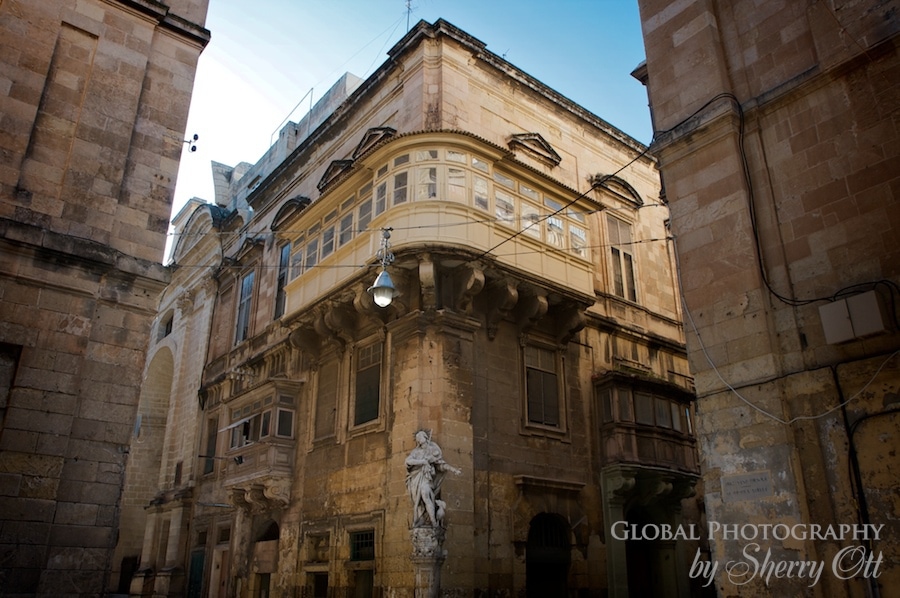
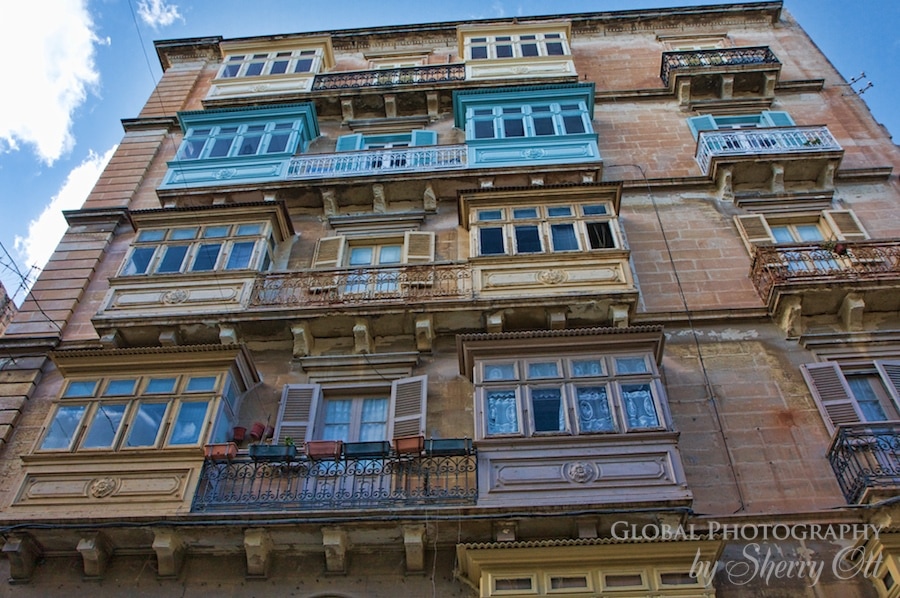
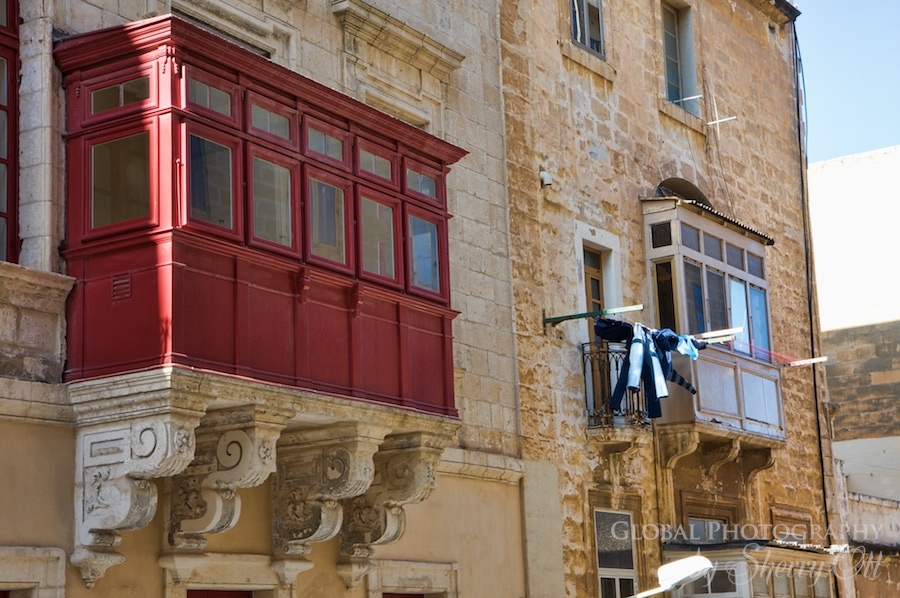







I really enjoyed this post. I visited Malta and did not even notice the enclosed balconies. I recall seeing them but for some reason if never stood out as something that is unique to Malta. Funny how some things will standout to one person and not another. I look forward to more of your post on your time in Europe.
I can’t believe you didn’t notice them! Wow…what did stand out to you then…maybe it’s something I’m missing!
I don’t think you could miss the things that really stood out to me. The huge walls of the cities, the color of the water and the way the island seemed to appear to be such a dry place that is surrounded by water. The other thing is just from my being stupid but for some reason I always think of knights as being English and the knights in Malta where from all over Europe.
I also was impress with the rust colored beaches I visited on Gozo. Just have never seen a beach that color before.
This is too cool! I had never heard or seen this anywhere else before. I love learning unique things like this. Great eye on the photos (as always) too.
Back in 2006, I had written my dissertation on the “Maltese balcony”, titled “The Maltese timber balcony: past, present & future.” The section on the origins of the Maltese closed timber balcony was very inserting and covered many possibilities, some of which you have correctly explained above. I had looked into the ideologies of the time, as well as the resources available to the island, and the skills and know how of the Maltese at the time when the typical Maltese “gallarija” started appearing. One of the origins, the similarities of which I found intriguing where that of the Maltese timber balcony with the ‘balcony-like’ structures found at the stern of the 16th century Galleys. (http://melita2historica.x90x.net/hw19946.html). I found the similarities in proportions, colours, design, etc. to be too much of a coincidence, especially since probably the first timber balcony appeared on the Grandmaster’s Palace, who would have been one of the only people to be in a position to have all the materials and skilled labourers available and at his disposal, to reproduce these structures. Obviously this doesn’t exclude the ‘muxarabija’ influence, but merely could shed light on the construction techniques, designs and variations which are present in the balcony we find around Malta today.
Hi! I studied art history at the University of Malta a few years ago. You’ve got it right with the muxrabija influence, as well as a bit of Arabic and Aragonese (Spanish). Although be careful – there are examples of stone versions of muxrabija in Malta, so it’s important to differentiate between the two.
From what I heard around the university, Maltese balconies were just kind of a fad in the 18th century that persisted up until today. Cute, but often destroying the historical authenticity of the facades of many buildings, having been added as an after-thought later. Your last photo of the red balcony is a fine example of this – look how it has been plopped right on top of the windows! This kind of thing drove my architecture profs nuts.
If you want a definitive answer I highly recommend going to a Maltese architecture book (I love Malta: The Baroque Island by C. Thake), or contacting a prof at UOM. They are the (worldwide – surprise!) experts in this kind of thing!
Thanks for letting me know I’m on the right track! I loved the architecture there!
Believe it or not, I haven’t really paid too much attention to these balconies. I will start looking around me (and above) on my walk to work tomorrow. Interesting post.
Thanks for sharing such a wonderful maltese balcony origins…
Great photos! And learned something new about balconies.
Thanks for all the enlightening posts. We fell in love with the muxrabija while in Malta in 2012.
Arabic and Spanish cultures both have balconies, and it could be argued that the Arabs introduced balconies to the Spanish culture.
While it is possible that stone balconies were around during the Arab occupation which ended in 1091 AD, the wooden balconies which are so popular today were introduced in the seventeenth century, (have a millenium after the end of the Arab occupation).
The Order of Saint John was a European chivalric Order with influences… well from Europe. And in the balconies’ case; from Spain.
Thanks for the background!
I was in Malta last month and noticed all of these beautiful balconies too – I couldn’t help wondering what it was all about. Thanks for doing the research:)
Hi Sherry,
Nice pictures – your informer was right on reason for building these covered-balconies. I have written a paper that might interest you – I can send it to you if interested. I liked the picture of the highchair and I was wondering if I have your permission to use it in my further writings. Regards, Cyrus
Hi Cyrus – thanks for your comments and info. Sorry I was slow in answering – I’m on the road right now and hard to keep up with everything! Can you let me know what your future writings are about – or how you’ll use the image? I’m sure I’ll let you use it – but just want to understand what the audience is. You can email me at info(at)ottslworld(dot)com
https://vassallohistory.wordpress.com/the-maltese-balcony/
The Maltese Wooden Balcony
Small-scale wooden balconies started to appear in Valletta during the mid-eighteenth century and gradually gained popularity and became the fashion.
Due to the many employment possibilities and wealth generated by the British port activities, the Grand Harbour region faced an immense population influx in the early 19th century. This in turn created immense population pressure on a relatively small area and considerable sanitary problems ensued. Most of the tenements of the area were built between the 16th century and 17th century had very basic sanitary arrangements. The cholera epidemic of 1865 highlighted the problem in a dramatic way and hastened the implementation of a sanitary strategy. Valletta shared the same sanitary problems as many big European cities faced with the situations triggered by the Industrial Revolution and the exodus from the countryside to the city.
Water closets were one of the solutions but a whole infrastructure was required to sustain these. Many were installed either between recesses in double stone walls along staircases or in existing or purpose- built wooden balconies. Existing balconies had to be altered to serve this less noble architectural and human need. The side windows of the balcony, and a few adjacent ones, were rendered opaque by being painted over or were fitted with louvered shutters to afford a degree of privacy. In some instances the base was extended so as to accommodate the drainpipes that ran out of it and along the facades. Even the Palace balcony on Archbishop Street had a similar arrangement that was only removed in 1989. The situation only started to change drastically at the turn of the 20th century and took 50 years to reach acceptable standard. Until 1967 in Valletta there were still 183 buildings with a common lavatory for all the tenants.
I saw that a balcony could only project one hand from a wall on some web site that I can not find now. I wasn’t looking for information on balconies at the time so I did not record the information. I was looking for information on a building in either Spain or Portugal at the time. I think the site said that the projection at bottom of balcony with a second, greater projection at mid-height was prevent closing in already narrow streets.
Gosh, I love these so much!
I wandered on Maltese streets photographing the beautiful traditional balconies. I remember them so often…
Great post! Thank you for sharing. Hope to hear more from you.
In Wikipedia the stern or quarter gallery is defined as “an architectural feature of the stern of a sailing ship from around the 16th to the 19th century. Quarter galleries are a kind of balcony, typically placed on the sides of the stern castle, the high, tower-like structure at the back of a ship that housed the officer’s quarters. They functioned as a firing platform for the ship’s marines and sharpshooters during boarding actions. The galleries also provided a structure that was ideally suited for attaching decoration and often bore carved wooden sculptures, particularly in the 17th century”.
In an article “Interview: Conserving Quaint Maltese balconies” carried by the Malta Independent on Monday, 26 April 2010, these balconies, which in Maltese are referred to as ’gallariji’, where the similarity with gallery should not be ignored, you will get this definition: “The balcony, especially the closed balcony, satisfied the human need of a refuge and prospect. The balcony required advances in architecture, craftsmanship and availability of people who could do that craft and material to make the balcony. Balconies served as an extension to the residence, throughout the ages.”
In Malta you can have the simplest humble balconies to the most intricate corner ones that wrap themselves around building facades. It is quite obvious that these structures like a belvedere would have offered the occupants a commanding view of the surrounding scenery.
That Malta and Gozo sit right at the centre of the Mediterranean, where ships of different flags and religions converged is recorded in a good number of history books. Since antiquity Malta attracted the attention of dominant powers and for this reason it has been fought over endlessly. Moreover, the confluence of the major shipping arteries that pumped a regular stream of ships and the wealth they carried, in and out of Malta was a magnet for corsairs and pirates.
When ships were in port ship’s crew and officers often grew restless; the call of the sea was just too loud to ignore and even with the perils that awaited them, they longed to set sail again. This call was amplified when they retired, so it is my educated guess and belief that having this balcony, the gallery like structure protruding out from a building facade overlooking a sea view, would have given the sensation of being on board and helped ease their yearning. So, the possibility that the Maltese gallarija may be related to the stern gallery that jutted out from the ship’s captain quarters should be considered.
Of particular interest is the fact that rather than offering refuge, these balconies that are still so much in evidence on the Maltese islands, with the best of them supported on some of the most intricately carved stone supports called ‘saljaturi’ would have served as excellent firing platforms just like their naval counterparts.
And just like those carved wooden decorations found at the prow of ships, the figureheads would in time be represented by those small chrome figures that adorned early 20th century cars that denoted the marques, and with some of the wooden coach work styles referred to as ‘boat tail’, the Maltese balcony might just be a representation of the ship’s gallery that was mounted on the stern of a ship.
I have an antique Maltese Wooden Balcony for sale. It’s a complete balcony, with very rare wooden freize and still in very good condition. Anybody interested may contact me.
Aside from the various functions that the balconies may have served originally, I heard that they gained popularity among the wealthy Maltese as symbols of social and financial status since wood was a rare commodity on the island and a costly import.
Thanks for your input!
It’s an old Byzantine tradition but it came from Ottoman Empire to Malta. There are thousands traditional balconies in Istanbul or other Anatolian cities.
Lot of similar balconies in the old part of jeddah,which was part of the Ottoman Empire.
Many balconies in the old part of jeddah which was part of the Ottoman Empire for 800 years.